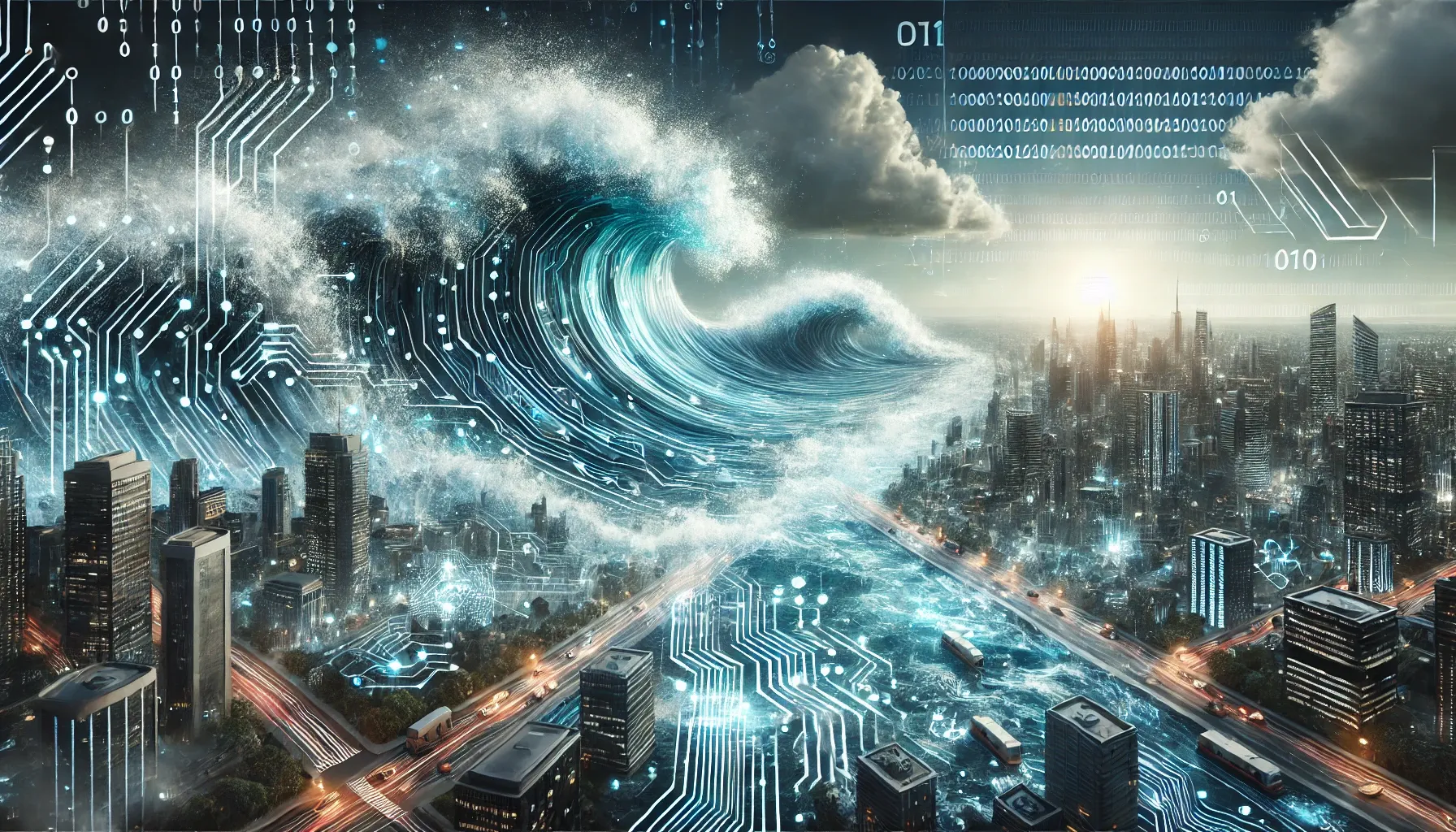
Have Alex read this article for you:

In the vast ocean of technological progress, there’s a silent tsunami building—one that’s largely unnoticed by the world at large but is quietly growing in the depths of the developer community. This metaphorical tsunami is Artificial Intelligence (AI), a force that, like a massive wave forming far from shore, is gathering momentum. While it might seem distant and irrelevant to many now, its impact will soon crash onto the shores of society with transformative power. The question is not if, but when, and more importantly, how this wave will change the landscape of our lives.
The Invisible Force of Change
Imagine a tsunami building in the deep ocean. Out there, where the waters are vast and mysterious, its presence is barely detectable. Ships pass by, unaware of the force beneath them, until the wave reaches shallower waters, where it rises with terrifying speed and power. Similarly, AI is developing in the deep waters of the tech world, where its advancements are largely invisible to those outside the field. But soon, this force will rise, and when it does, it will be impossible to ignore.
AI is already infiltrating various aspects of our lives, from recommendation algorithms on social media to voice assistants in our homes. Yet, these are just the ripples on the surface. The real wave—the one that will redefine entire industries, reshape economies, and alter the fabric of society—is still on its way. And when it arrives, it will do so with a force that will leave nothing untouched.
Exponential Growth and the Power of Feedback Loops
What makes AI different from many other technological advancements is its potential for exponential growth. Unlike linear developments, where progress is steady and predictable, AI is a catalyst—a technology that accelerates its own advancement. This self-reinforcing loop is what makes AI so powerful and so unpredictable.
Every breakthrough in AI doesn’t just add to the existing body of knowledge; it paves the way for further breakthroughs. Each new development enables others, creating a chain reaction of innovation that feeds back into itself. This positive feedback loop means that the pace of AI advancement is not just fast—it’s accelerating. As AI becomes more capable, it will unlock new possibilities, leading to even more rapid progress.
This exponential growth is akin to a snowball effect, where a small push at the top of a hill can lead to a massive, unstoppable force by the time it reaches the bottom. In the case of AI, the small pushes are the current advancements we see in natural language processing, computer vision, and machine learning. The unstoppable force is what happens when these technologies converge and begin to transform everything from healthcare to finance to education.
AI as a Catalyst for Broader Change
AI is not just another technological tool; it’s what some might call a “power technology.” Power technologies are those that don’t just improve one aspect of society—they redefine the entire framework within which society operates. Think of the steam engine in the early 1800s, which powered the Industrial Revolution and transformed economies, or the distribution of electrical power in the late 1800s, which brought light and energy to every corner of the world. These were not just incremental improvements; they were catalysts for profound change.
AI fits into this category because it amplifies human capacity in ways that allow us to transcend our current limitations. It’s a technology that doesn’t just stay in its own space; it spills over into every domain it touches, creating new possibilities and disrupting old paradigms. It’s the kind of technology that breaks the ice, allowing us to venture into previously uncharted territories.
"It will change not just what we do, but how we think about what we can do."
But AI is more than just a tool for efficiency. It’s a tool for creativity, for innovation, for re-imagining what is possible. As AI becomes more integrated into our lives, it will enable new ways of thinking, new ways of organizing, and new ways of doing. It will change not just what we do, but how we think about what we can do.
Shifting the Boundaries of Human Capacity
Throughout history, certain technologies have fundamentally shifted the boundaries of what humans can achieve. The steam engine allowed us to harness energy in ways that revolutionized transportation and manufacturing. Electricity gave us the power to communicate instantly across vast distances and to work and live in ways that were previously unimaginable. These technologies didn’t just improve our capabilities; they redefined them.
AI is poised to be the next in this line of transformative technologies. It’s a technology that amplifies human intelligence, allowing us to solve problems that were previously beyond our reach. It’s a technology that extends our capacity to learn, to create, and to innovate. And, like its predecessors, it will lead to a reordering of society as new possibilities and practicalities become available.
Imagine a world where AI is integrated into every aspect of our lives—where it helps us make decisions, solve problems, and even create new ideas. In this world, the boundaries of human capacity are not just extended; they are redefined. We will move beyond the practical limits we’ve reached, and in doing so, we will discover new frontiers that were previously unimaginable.
The Historical Parallels and the Future Ahead
The parallels between AI and past technological revolutions are striking. Just as the steam engine powered the Industrial Revolution and electricity transformed communication and industry, AI has the potential to redefine what humans can achieve. But there’s a key difference: while past technologies amplified our physical capacities, AI amplifies our cognitive capacities. It’s not just about moving goods or services more efficiently; it’s about moving ideas, about thinking in new ways, and about unlocking new potentials that will take us further than we’ve ever gone before.
The silent tsunami of AI is approaching, and with it comes a wave of change that will redefine our world. It’s a change that will challenge our current systems, disrupt our traditional ways of thinking, and open up new possibilities that we can only begin to imagine. As this wave crashes onto the shores of society, it will reshape the landscape, leaving nothing untouched.
The question we must ask ourselves is: are we ready for it? Are we prepared to navigate the deep waters of AI, to harness its power, and to steer it towards a future that benefits us all? The silent tsunami is on its way, and how we respond to it will define the next chapter of human history.
AIT

